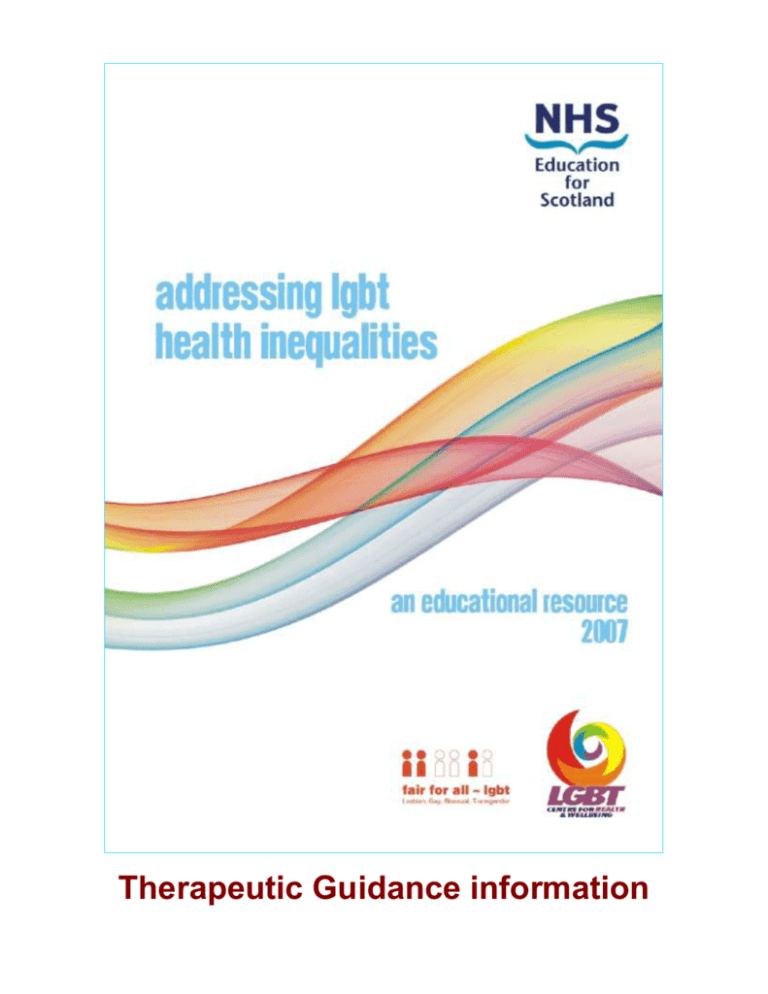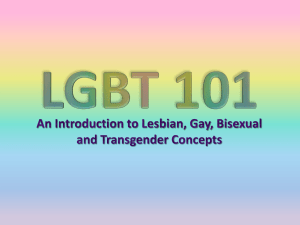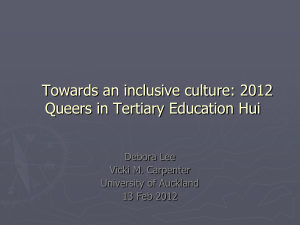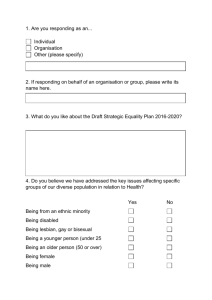Therapeutic guidance information
advertisement

Therapeutic Guidance information Guidelines for Psychotherapy with Lesbian, Gay, and Bisexual Clients Introduction The Division 44 Committee on Lesbian, Gay, and Bisexual Concerns Joint Task Force, as part of the American Psychological Association, developed a set of affirming guidelines designed to underpin psychological work with lesbian, gay and bisexual clients. The full text of this guidance is available on APA website The guideline headings, which offer useful principles for therapeutic work with LGB people, are: Attitudes toward Homosexuality and Bisexuality Guideline 1 Psychologists understand that homosexuality and bisexuality are not indicative of mental illness. Guideline 2 Psychologists are encouraged to recognize how their attitudes and knowledge about lesbian, gay, and bisexual issues may be relevant to assessment and treatment and seek consultation or make appropriate referrals when indicated. Guideline 3 Psychologists strive to understand the ways in which social stigmatization (i.e., prejudice, discrimination, and violence) poses risks to the mental health and well-being of lesbian, gay, and bisexual clients. Guideline 4 Psychologists strive to understand how inaccurate or prejudicial views of homosexuality or bisexuality may affect the client's presentation in treatment and the therapeutic process. Relationships and Families Guideline 5 Psychologists strive to be knowledgeable about and respect the importance of lesbian, gay, and bisexual relationships. Addressing LGBT health inequalities an educational resource 2007 2 Guideline 6 Psychologists strive to understand the particular circumstances and challenges faced by lesbian, gay, and bisexual parents. Guideline 7 Psychologists recognize that the families of lesbian, gay, and bisexual people may include people who are not legally or biologically related. Guideline 8 Psychologists strive to understand how a person's homosexual or bisexual orientation may have an impact on his or her family of origin and the relationship to that family of origin. Issues of Diversity Guideline 9 Psychologists are encouraged to recognize the particular life issues or challenges that are related to multiple and often conflicting cultural norms, values, and beliefs that lesbian, gay, and bisexual members of racial and ethnic minorities face. Guideline 10 Psychologists are encouraged to recognize the particular challenges that bisexual individuals experience. Guideline 11 Psychologists strive to understand the special problems and risks that exist for lesbian, gay, and bisexual youth. Guideline 12 Psychologists consider generational differences within lesbian, gay, and bisexual populations and the particular challenges that lesbian, gay, and bisexual older adults may experience. Guideline 13 Psychologists are encouraged to recognize the particular challenges that lesbian, gay, and bisexual individuals experience with physical, sensory, and cognitive-emotional disabilities. Education Guideline 14 Psychologists support the provision of professional education and training on lesbian, gay, and bisexual issues. Addressing LGBT health inequalities an educational resource 2007 3 Guideline 15 Psychologists are encouraged to increase their knowledge and understanding of homosexuality and bisexuality through continuing education, training, supervision, and consultation. Guideline 16 Psychologists make reasonable efforts to familiarize themselves with relevant mental health, educational, and community resources for lesbian, gay, and bisexual people. Transgender Emergence – a developmental model Introduction The following model offers a useful guide to assist in facilitating greater understanding of the transitionary processes that transgender people go through. Arlene Istar Lev (see details below) developed this model based on her own experience of supporting transgender people and is intended as a guide for therapists. The developmental model outlines six broad stages. As with any model, be aware that it offers a framework for understanding rather than a defined route, and that as people are individuals no two journeys will be the same, even although they may share common themes. A note on language The term Gender-Variant is commonly used in the US but less so in the UK. Addressing LGBT health inequalities an educational resource 2007 4 Stage The therapeutic task… Awareness In the first stage, gender-variant people are Is the normalisation of the often in great distress. experiences involved in emerging transgendered Seeking information/reaching out In the second stage, gender-variant people seek to gain education and support around transgenderism. Is to facilitate linkages and encourage outreach Disclosure to significant others The third stage involves the disclosure of transgenderism to significant others – spouses, partners, family members, and friends. Involves supporting the transgendered person’s integration into the family system. Exploration: identity and self-labelling The fourth stage involves the exploration of Is to support the articulation and various transgender identities. comfort with one’s gendered identity. Exploration: Transition issues/possible body modification The fifth stage involves exploring options for transition regarding identity, presentation and body modification. Is the resolution of the decisions and advocacy toward their manifestation Integration: Acceptance and posttransition issues In the sixth stage the gender-variant person Is to support adaptation to is able to integrate and synthesise transition-related issues. (transgender) identity. Addressing LGBT health inequalities an educational resource 2007 5 Reference Lev, Arlene Istar. Transgender Emergence: Therapeutic Guidelines for Working with Gender-Variant People and Their Families. New York, the Haworth Clinical Practice Press (2005) Other publications Finally, there are other publications providing guidance for therapists working with lesbian, gay, bisexual and transgender clients, all of which are available on www.amazon.co.uk Pink Therapy: A Guide for Counsellors and Therapists Working with Lesbian, Gay and Bisexual Clients Open University Press 1996. Dominic Davies & Charles Neal (Editors) Issues In Therapy With Lesbian, Gay, Bisexual And Transgender Clients (Paperback) Open University Press, 2000 Charles Neal and Dominic Davies Therapeutic Perspectives on Working with Lesbian, Gay and Bisexual Clients (Paperback) Open University Press 2000 Dominic Davies & Charles Neal (Editors) Handbook of Affirmative Psychotherapy with Lesbians and Gay Men (Hardcover) The Guilford Press 2002 Kathleen Y Ritter and Anthony I. Terndrup (Authors) Addressing LGBT health inequalities an educational resource 2007 6







